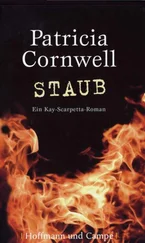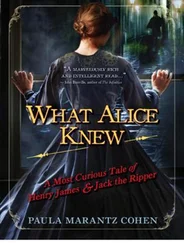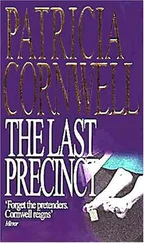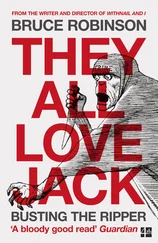Patricia Cornwell - Portrait Of A Killer - Jack The Ripper - Case Closed
Здесь есть возможность читать онлайн «Patricia Cornwell - Portrait Of A Killer - Jack The Ripper - Case Closed» весь текст электронной книги совершенно бесплатно (целиком полную версию без сокращений). В некоторых случаях можно слушать аудио, скачать через торрент в формате fb2 и присутствует краткое содержание. Жанр: Триллер, на английском языке. Описание произведения, (предисловие) а так же отзывы посетителей доступны на портале библиотеки ЛибКат.
- Название:Portrait Of A Killer: Jack The Ripper - Case Closed
- Автор:
- Жанр:
- Год:неизвестен
- ISBN:нет данных
- Рейтинг книги:5 / 5. Голосов: 1
-
Избранное:Добавить в избранное
- Отзывы:
-
Ваша оценка:
- 100
- 1
- 2
- 3
- 4
- 5
Portrait Of A Killer: Jack The Ripper - Case Closed: краткое содержание, описание и аннотация
Предлагаем к чтению аннотацию, описание, краткое содержание или предисловие (зависит от того, что написал сам автор книги «Portrait Of A Killer: Jack The Ripper - Case Closed»). Если вы не нашли необходимую информацию о книге — напишите в комментариях, мы постараемся отыскать её.
Portrait Of A Killer: Jack The Ripper - Case Closed — читать онлайн бесплатно полную книгу (весь текст) целиком
Ниже представлен текст книги, разбитый по страницам. Система сохранения места последней прочитанной страницы, позволяет с удобством читать онлайн бесплатно книгу «Portrait Of A Killer: Jack The Ripper - Case Closed», без необходимости каждый раз заново искать на чём Вы остановились. Поставьте закладку, и сможете в любой момент перейти на страницу, на которой закончили чтение.
Интервал:
Закладка:
Unless Jack the Ripper was incredibly stupid, he would have removed the side of folded stationery that was embossed with the address. This is not to say that criminals haven't been known to make numbskull oversights, such as leaving a driver's license at a crime scene or writing a "stick-up" note on a deposit slip that includes the bank robber's address and Social Security number. But Jack the Ripper did not make fatal errors, or he would have been caught at the time of his crimes.
Jack the Ripper was also arrogant and did not believe he would ever be caught. Sickert must not have been worried about the partial watermarks on the Ripper letters he wrote. Perhaps this was another "catch me if you can" taunt. The A Pirie amp; Sons watermarks we found on Sickert stationery include a watermarked date of manufacturing, and the three partial dates on the Ripper letters with the A Pirie amp; Sons watermark are 18 and 18 and 87. The 87, obviously, is 1887.
Repeated trips to archives turned up other matching watermarks that must not have worried Sickert, either. Letters Sickert wrote to Jacques-Emile Blanche in 1887 are on stationery with the address embossed in black, and a Joynson Superfine watermark. A search through the Blanche-Sickert correspondence in the Institut Bibliotheque de L'Institut de France in Paris shows that during the late summer and fall of 1888 and in the spring of 1889, Sickert was still using Joynson Superfine paper with the return address of 54 Broadhurst Gardens either embossed with no color or in bright red with a red border.
Letters Ellen wrote to Blanche as late as 1893 with a 10 Glebe Place, Chelsea, return address are on stationery that also has the Joynson Superfine watermark. In the Whistler collection at Glasgow, there are seven Sickert letters with the Joynson Superfine watermarks, and it would appear that Sickert was using this stationery about the same time he was using A Pirie amp; Sons.
In the Sir William Rothenstein collection at Harvard University's Department of Manuscripts, I found two other Sickert letters with the Joynson Superfine watermark. Rothenstein was an artist and a writer, and a trusted enough friend of Sickert's that the latter felt comfortable asking him to lie under oath. During the late 1890s, Sickert had become friendly with a Madame Villain, a fishwife in Dieppe he referred to as "Titine." Although there was no evidence he committed adultery with her, she did supply him room and board and a space in her small home that he used as a studio. Whatever the nature of their relationship, it would have been used against him in court had he contested Ellen's divorce suit, which he did not. "If subpoenaed," he wrote to Rothenstein in 1899, during the divorce, "you might truly remain as you are in ignorance of Titine's very name. You might say I always call her 'Madame.' "
Both Joynson Superfine watermarked letters that Sickert wrote to Rothenstein are undated. One of them - oddly, written in German and Italian - is on stationery that must have belonged to Sickert's mother because the return address is hers. A second Joynson Superfine watermarked letter to Rothenstein, which includes mathematical scribbles and a cartoonish face and the word "ugh," has a return address of 10 Glebe Place, Chelsea, which is the same return address on Ellen Sickert's 1893 letter to Blanche. There is a Ripper letter at the PRO with a part Joynson mark. It would appear that Sickert used Joynson Superfine watermarked paper from the late 1880s through the late 1890s. I have found no letters with this watermark that date from after his divorce in 1899, when he moved to continental Europe.
Four letters catalogued in "The Whitechapel Murders" file at the Corporation of London Records Office were written on Joynson Superfine paper: October 8, 1888; October 16, 1888; January 29, 1889; and February 16,1889. Two of these letters are signed "Nemo." Three other letters with no watermarks are also signed "Nemo." On October 4, 1888 (four days before the first "Nemo" letter was written to the City of London Police), The Times published a letter to the editor that was signed "Nemo." In it the writer described "mutilations, cutting off the nose and ears, ripping up the body, and cutting out certain organs - the heart, amp; c. -…" The writer continued:
My theory would be that some man of his class has been hocussed and then robbed of his savings (often large), or, as he considers, been in some way greatly injured by a prostitute - perhaps one of the earlier victims; and then has been led by fury and revenge to take the lives of as many of the same class as he can…
Unless caught red-handed, such a man in ordinary life would be harmless enough, polite, not to say obsequious, in his manners, and about the last a British policeman would suspect.
But when the villain is primed with his opium, or bang, or gin, and inspired with his lust for slaughter and blood, he would destroy his defenceless victim with the ferocity and cunning of the tiger; and past impunity and success would only have rendered him the more daring and restless.
Your obedient servant October 2 NEMO
I have already mentioned that Sickert's stage name when he was an actor was "Mr. Nemo."
Other unusual signatories in the some fifty letters at the Corporation of London Records Office are suspiciously reminiscent of those of some PRO Ripper letters: "Justitia," "Revelation," "Ripper," "Nemesis," "A Thinker," "May-bee," "A friend," "an accessary," and "one that has had his eyes opened." Quite a number of these fifty letters were written in October 1888 and also include both art and comments similar to those found in the Jack the Ripper letters at the PRO. For example, in a PRO letter to the Editor of the Daily News Office, October 1, 1888, the Ripper says, "I've got someone to write this for me." In an undated letter at the Corporation of London Records Office, the anonymous sender says, "I've got someone to write this for me."
Other "Whitechapel Murder" letters in the Corporation of London Records Office include a postcard dated October 3rd, with the anonymous sender using many of the same threats, words, and phrases found in Ripper letters at the PRO: "send you my victims ears"; "It amuses me that you think I am mad"; "Just a card to let you know"; "I will write to you again soon"; and "My bloody ink is running out." On October 6,1888, "Anonymous" offers a suggestion that the killer might be keeping "the victims silent by pressure on certain nerves in the neck," and adds that an additional benefit to subduing the victim is that the killer can "preserve his own person and clothing comparatively unstained." In October 1888, an anonymous letter written in red ink uses the terms "spanky ass" and "Saucy Jacky" and promises to "send next ears I clip to Charly Warren."
An undated letter includes a bit of newspaper attached by a rusty paperclip. When my co-worker, Irene Shulgin, removed the clipping and turned it over, she found the phrase "author of works of art." In a letter dated October 7, 1888, the writer signs his name "Homo Sum," Latin for "I am a man." On October 9, 1888, an anonymous writer takes offense, once again, at being thought of as a lunatic: "Don't you rest content on the lunacy fad." Other anonymous letters offer tips to the police, encouraging officers to disguise themselves as women and wear "chain armour" or "light steel collars" under their clothes. An anonymous letter of October 20, 1888, claims the "motive for the crimes is hatred and spite against the authorities of Scotland Yard one of whom is marked as a victim."
In a July 1889 letter a writer signs his letter "Qui Vir," Latin for "Which Man." In a letter Sickert wrote to Whistler in 1897, he rather sarcastically refers to his former "impish master" as "Ecce homo," or "behold the man." In the "Qui Vir" letter, which is at the Corporation of London Records Office, the writer suggests that the killer is "able to choose a time to do the murder 8c get back to his hiding place." On September 11,1889, an anonymous writer teases police by saying he always travels in "third class Cerage" and "I ware black wiskers all over my face." Approximately twenty percent of these Corporation of London Records Office letters have watermarks, including, as I mentioned, the Joynson Superfine. I also found a Monckton's Superfine watermark on a letter signed "one of the public." A letter Sickert wrote to Whistler in the mid to late 1880s also has a Monckton's Superfine watermark.
Читать дальшеИнтервал:
Закладка:
Похожие книги на «Portrait Of A Killer: Jack The Ripper - Case Closed»
Представляем Вашему вниманию похожие книги на «Portrait Of A Killer: Jack The Ripper - Case Closed» списком для выбора. Мы отобрали схожую по названию и смыслу литературу в надежде предоставить читателям больше вариантов отыскать новые, интересные, ещё непрочитанные произведения.
Обсуждение, отзывы о книге «Portrait Of A Killer: Jack The Ripper - Case Closed» и просто собственные мнения читателей. Оставьте ваши комментарии, напишите, что Вы думаете о произведении, его смысле или главных героях. Укажите что конкретно понравилось, а что нет, и почему Вы так считаете.












